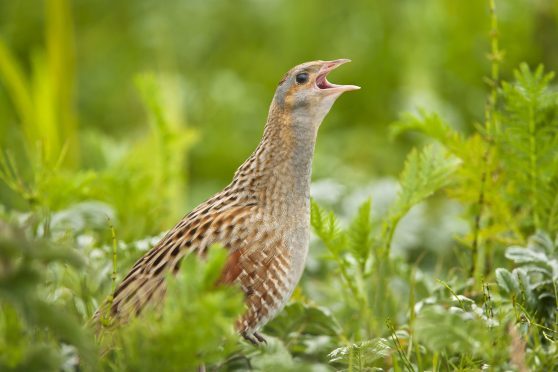The corncrake, one of Scotland’s rarest breeding birds, has suffered a poor season with numbers dropping by nearly a fifth.
In an annual RSPB Scotland survey, the number of calling males recorded fell by 17% compared to last year, with only 1,069 being counted.
In 2014 there were 1,289 calling males counted – the highest total in at least 45 years.
Corncrakes are elusive, pigeon-sized birds which breed in Scotland over the spring and summer, migrating to Africa in winter. They are found in only a few isolated parts of the country, mainly on the islands.
The isle of Tiree holds the most corncrakes with 333 calling males counted in 2015. Nearly all parts of the country that corncrakes occupy witnessed a drop in numbers this year, except for a few places like the islands of Islay and Iona which both had a slight increase, and the isle of Mull which stayed the same.
Paul Walton, Head of Habitat and Species for RSPB Scotland, said: “The corncrake has recovered well since the early 1990s, and that’s thanks to agricultural communities on the islands. But now that recovery has slowed and numbers are fluctuating, we think in response to cold spring weather.
“This species remains a huge conservation priority in Scotland. We must remember that the corncrake remains highly localised. Though numbers have increased, the conservation programme has not yet succeeded in spreading the population further than its low point in 1991. It is difficult to fund crofters to deliver land management in areas where corncrakes are currently absent – but that’s the only way to start increasing the birds’ range – the vital next step towards a robust and secure national population.”
Corncrakes also suffered a decline in Scotland in 2013 – with a 23% drop compared with the previous year – but they did recover in 2014. It is thought that the exceptionally cold, late springs in 2013 and 2015 is the reason behind the reduction in the number of males calling.
Despite these recent fluctuations, however, corncrakes have recovered hugely since the early 1990s. At that time the species, which was common right across Scotland, England, Wales and Ireland in the 19th century, had dwindled to just 400 calling males. These were almost entirely restricted to a few Scottish islands.
Research by RSPB Scotland identified changing agricultural activities, especially a shift to earlier mowing of hay meadows and silage fields, as the main cause of the declines.
